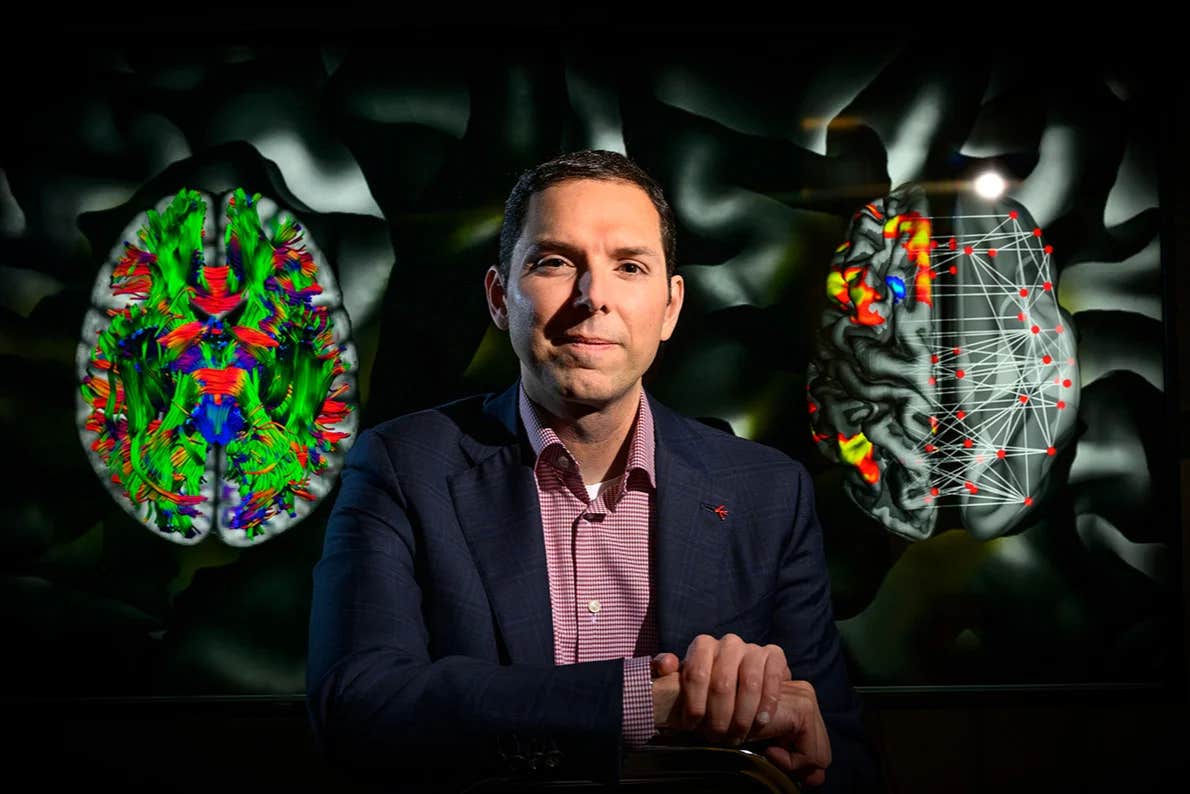This is the most accurate predictor of human intelligence, study finds
For decades, the intricate interplay between brain structure and functional connectivity underlying human intelligence has remained a mystery

U. of I. professor Aron Barbey, pictured, and co-author Evan Anderson found that taking into account the features of the whole brain – rather than focusing on individual regions or networks. (CREDIT: University of Illinois Urbana-Champaign)
For decades, scientists have been on a relentless quest to unravel the mysteries of intelligence. The intricate interplay between brain structure and functional connectivity that underlies human intelligence has remained an enigma.
However, a groundbreaking analysis has recently offered unprecedented insight into how various brain regions and neural networks contribute to a person's problem-solving abilities, shedding light on the elusive trait known as general intelligence.
This research, led by Aron Barbey, a distinguished professor of psychology, bioengineering, and neuroscience at the University of Illinois Urbana-Champaign, in collaboration with Evan Anderson, a researcher for Ball Aerospace and Technologies Corp. working at the Air Force Research Laboratory, provides a fresh perspective on the biological foundations of intelligence.
Their findings, published in the journal Human Brain Mapping, offer a clearer picture of the brain's role in problem-solving and adaptability.
The study employs a novel approach known as "connectome-based predictive modeling" to explore five prominent theories about the neural mechanisms driving intelligence.
Related Stories
As Aron Barbey explains, "To understand the remarkable cognitive abilities that underlie intelligence, neuroscientists look to their biological foundations in the brain."
Modern theories seek to show how the brain's information-processing architecture enables problem-solving capacity. Evan Anderson elaborates on the need for a biological understanding, emphasizing the importance of "characterizing how individual differences in intelligence and problem-solving ability relate to the underlying architecture and neural mechanisms of brain networks."
Traditionally, theories of intelligence have concentrated on localized brain regions, such as the prefrontal cortex, renowned for its role in cognitive functions such as planning, problem-solving, and decision-making.
More recent theories have shifted their focus towards specific brain networks, while others delve into the intricate interactions between different networks. Barbey and Anderson put these established theories to the test against their own "network neuroscience theory," which posits that intelligence emerges from the global architecture of the brain, encompassing both strong and weak connections.
Anderson clarifies the distinction between these connections, stating that "Strong connections involve highly connected hubs of information-processing that are established when we learn about the world and become adept at solving familiar problems."
On the other hand, weak connections, while fewer in number, provide flexibility and adaptive problem-solving capabilities. Together, these connections form the network architecture essential for tackling the diverse challenges we encounter in life.
To evaluate their hypotheses, the research team enlisted a diverse group of 297 undergraduate students. Initially, each participant underwent a battery of comprehensive tests designed to measure problem-solving skills and adaptability across various contexts, assessments routinely used to gauge general intelligence.
Subsequently, the team collected resting-state functional MRI scans for each participant. Aron Barbey highlights the uniqueness of the human brain: "One of the really interesting properties of the human brain is how it embodies a rich constellation of networks that are active even when we are at rest." These networks constitute the biological framework of the mind and are believed to be intrinsic properties of the brain.
Notable among them are the frontoparietal network, responsible for cognitive control and goal-directed decision-making; the dorsal attention network, which aids in visual and spatial awareness; and the salience network, directing attention towards the most relevant stimuli.
Previous studies have demonstrated that the activity of these networks, when an individual is awake but not engaged in a task or external stimuli, reliably predicts cognitive skills and abilities.
The convergence of cognitive tests and fMRI data enabled the researchers to assess which theories best predicted participants' performance on intelligence tests.
Evan Anderson explains, "We can systematically investigate how well a theory predicts general intelligence based on the connectivity of brain regions or networks that theory entails." This approach facilitated a direct comparison of the neuroscience predictions generated by various theories.
The results were unequivocal – taking into account the features of the entire brain yielded the most accurate predictions regarding an individual's problem-solving abilities and adaptability. Remarkably, this held true even when accounting for the number of brain regions included in the analysis. While the other theories also demonstrated predictive power, the network neuroscience theory surpassed them, excelling in multiple aspects.
The implications of these findings are profound. They illuminate the concept that "global information processing" within the brain is at the core of an individual's cognitive prowess. Rather than originating from a specific region or network, intelligence appears to be an emergent property of the brain's global architecture, reflecting its efficiency and flexibility in network-wide functioning.
Aron Barbey's involvement extends beyond this study. He is a faculty member in the Beckman Institute for Advanced Science and Technology, the Carl R. Woese Institute for Genomic Biology, and a professor of speech and hearing science, in addition to being a member of the neuroscience program at the University of Illinois Urbana-Champaign.
His multidisciplinary approach underscores the significance of collaboration and innovation in unlocking the secrets of the human mind.
As we delve deeper into the intricate neural networks that underpin our cognitive abilities, we inch closer to unraveling the profound mysteries of human intelligence, opening doors to enhanced problem-solving, adaptability, and the potential to unlock the full capabilities of the human mind.
Note: Materials provided above by The Brighter Side of News. Content may be edited for style and length.
Like these kind of feel good stories? Get The Brighter Side of News' newsletter.
Joseph Shavit
Head Science News Writer | Communicating Innovation & Discovery
Based in Los Angeles, Joseph Shavit is an accomplished science journalist, head science news writer and co-founder at The Brighter Side of News, where he translates cutting-edge discoveries into compelling stories for a broad audience. With a strong background spanning science, business, product management, media leadership, and entrepreneurship, Joseph brings a unique perspective to science communication. His expertise allows him to uncover the intersection of technological advancements and market potential, shedding light on how groundbreaking research evolves into transformative products and industries.



